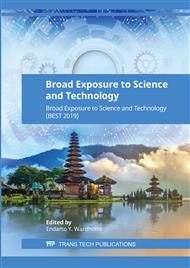[1]
M. Siegert, J. Sitte, A. Galushko, M. Kruger, Starting up microbial enhanced oil recovery, Adv Biochem Eng Biotechnol 142 (2014) 1–94.
Google Scholar
[2]
N. Dave, T. Joshi, A concise review on surfactants and its significance, International Journal of Applied Chemistry 13 (3) (2017) 663-672.
DOI: 10.37622/ijac/13.3.2017.663-672
Google Scholar
[3]
R. Azarmi, A. Ashjaran, Type and application of some common surfactants, Journal of Chemical and Pharmaceutical Research, 7 (2) (2015) 632-640.
Google Scholar
[4]
S.J. Geetha, I.M. Banat, S.J. Joshi, Biosurfactants: production and potential applications in microbial enhanced oil recovery (MEOR), Biocatalysis and Agricultural Biotechnology 14 (2018) 23 –32.
DOI: 10.1016/j.bcab.2018.01.010
Google Scholar
[5]
R.C.F. Silva, D.G. Almeida, R.D. Rufino, J.M. Luna, V.A. Santos, L.A. Sarubbo, Review: Applications of Biosurfactants in the Petroleum Industry and the Remediation of Oil Spills, Int J Mol Sci. 15 (2014) 12523-12542.
DOI: 10.3390/ijms150712523
Google Scholar
[6]
J.G. Speight, N.S. El-Gendy, Introduction to Petroleum Biotechnology. Cambridge: Elsevier, 2017. ISBN: 978-0-12-805151-1.
Google Scholar
[7]
M.F. Edbeib, R.A. Wahab, F. Huyop, Halophiles: biology, adaptation, and their role in decontamination of hypersaline environments, World J Microbiol Biotechnol. 32 (2016) 135.
DOI: 10.1007/s11274-016-2081-9
Google Scholar
[8]
H. Humaida, A. Zaennudin, N.E. Sutaningsih, The Outburst of gas and water mixing at Pari Temple village, Porong District, Sidoarjo Regency, East Java, J. Lingkungan dan Bencana Geol 3(1) (2012) 1 – 19.
Google Scholar
[9]
M. Asy'ari, P. Parwata, P. Aditiawati, A. Akhmaloka, R. Hertadi, Isolation and Identification of Halostable Lipase Producing Bacteria from the Bledug Kuwu Mud Crater Located at Purwodadi-Grobogan, Central Java, Indonesia, Journal of Pure and Applied Microbiology 8 (2014) 3387-3396.
DOI: 10.1016/j.proche.2015.12.069
Google Scholar
[10]
C. Mulligan, D. Cooper, R. Neufeld, Selection of microbes producing biosurfactants in media without hydrocarbons, J Fermentation Technol. 62(4) (1984) 311 – 314.
Google Scholar
[11]
S. Shalel, S. Streichman, A. Marmur, The Mechanism of Hemolysis by Surfactants: Effect of Solution Composition, J Colloid Interface Sci. 252(1) (2002) 66-76.
DOI: 10.1006/jcis.2002.8474
Google Scholar
[12]
A. Zaragoza, F.J. Aranda, M.J. Espuny, J.A. Teruel, A. Marqués, A. Manresa, A. Ortiz, Hemolytic activity of a bacterial trehalose lipid biosurfactant produced by Rhodococcus sp.: evidence for a colloid-osmotic mechanism, Langmuir, 26(11) (2010) 8567-72.
DOI: 10.1021/la904637k
Google Scholar
[13]
R. Buxton, Blood agar plates and hemolysis protocols, (2005).
Google Scholar
[14]
L. Fracchia, M. Cavallo, M.G. Martinotti, I.M. Banat, Biosurfactants and Bioemulsifiers Biomedical and Related Applications: Present Status and Future Potentials, Biomedical Science and Engineering Technology (2012).
DOI: 10.5772/23821
Google Scholar
[15]
C. Yuliana, Produksi dan Karakterisasi Biosurfaktan dari Bakteri Halofilik Isolat Lokal Halomonas meridiana BK-AB4 dan Chromohalobacter japonicus BK-AB18, Thesis, Bandung Institute of Technology, (2014).
DOI: 10.25273/cheesa.v2i2.5410
Google Scholar
[16]
C.N. Sari, N.I. Fatimah, R. Hertadi, M. Gozan, Processing of ozonized biodiesel waste to produce biosurfactant using Pseudomonas aeruginosa for enhanced oil recovery, AIP Conf. Proc. Vol. 2085: 020054 (2019). 11th Regional Conference on Chemical Engineering (RCChE), Yogyakarta, 7 – 8 November 2018. Code 146164.
DOI: 10.1063/1.5095032
Google Scholar


